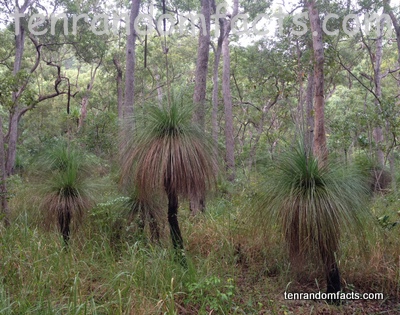Finding a grass tree specimen is not too difficult in Australia.
- Grass trees are a genus of roughly 30 species of perennial plants that are native exclusively to Australia.
- ‘Grass trees’ are also known as ‘grass gum-trees’, ‘yakkas’, ‘balgas’, and ‘balga grass’, as well as ‘blackboys’, though this name is somewhat controversial due to the plant’s comparison to indigenous Australians.
- The scientific name of the grass tree is Xanthorrhoea and it is from the family Asphodelaceae, a family of flowering plants.
- Grass trees generally have an almost spherical cluster of long, spiky grass-like leaves that form at the top of a trunk.
- The small flowers of grass trees grow along a tall cylindrical spike that can reach from 1 to 4.5 metres (3 to 15 feet) and sits above the plant.

- Grass trees can take a very lengthy time to grow; however, they can also live to be 600 years old; and the plants, depending on the species, can grow to 6 metres (20 feet) in height, not including the flower spike.
- Not all grass tree species have trunks, while some have branched trunks, yet others may only branch if they have been damaged.
- Some grass tree species have a natural procedure for combating bushfire devastation, by growing new flower spikes directly after experiencing a fire.
- Grass trees have been traditionally adapted by indigenous Australians to create spears, particularly using the plant’s leaf resin as an adhesive, and the plant’s flowers have also been made into a sweet drink.
- In World War II and prior, the resin of grass trees was put on tins and other metals to combat rust; and the resin was also used to create a lacquer; and sometimes used in churches to create a pleasing aroma, by burning the substance.
Bibliography:
Genus Xanthorrhoea, n.d, PlantNET, http://plantnet.rbgsyd.nsw.gov.au/cgi-bin/NSWfl.pl?page=nswfl&lvl=gn&name=Xanthorrhoea
Pawlan M, Australian Xanthorrhoea, n.d, Pawlan, http://pawlan.com/monica/australia/
Watson P, The Grass Tree: Its Use and Abuses, 2004, Australian Plants Online, http://anpsa.org.au/APOL33/mar04-5.html
Xanthorrhoea, 2016, Wikipedia, https://en.wikipedia.org/wiki/Xanthorrhoea





